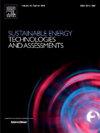Comparative life cycle assessment of micro water Turbines: Evaluating potential for remote power generation
IF 7
2区 工程技术
Q1 ENERGY & FUELS
Sustainable Energy Technologies and Assessments
Pub Date : 2024-11-24
DOI:10.1016/j.seta.2024.104107
引用次数: 0
Abstract
The growing interest in sustainable energy solutions, coupled with recent technological advancements, has led to increased exploration of ultra-low-head hydropower systems. This study focuses on micro water turbines, particularly zero- to low-head turbines, for off-grid power production. The primary objective is to assess the operational dynamics, performance-influencing variables, and utility of three specific turbine types: the Archimedes screw turbine (AST), water wheels (WW), and zero-head (hydrokinetic) turbines (ZHT). This article rigorously compares the life cycle assessments of these turbines, with an emphasis on energy, economic, and environmental analyses. In the context of rapid technological advancements and increasing sustainability challenges, adopting turbine technologies with over two decades of service life and desired outputs has become critical. Users now place greater importance on economic, energy, and environmental factors when selecting micro-turbine technologies. This paper introduces a new Selection Index (SI) based on life cycle assessment (LCA) to aid in selecting and adopting micro-turbine technologies for long-term operations. The selection index values of AST, WW, and ZHT are 2.532, 2.371, and 2.324, respectively, demonstrating that AST outperforms the other two in terms of energy intensity, economic viability, and environmental sustainability for low-head, off-grid power generation.

微型水轮机生命周期比较评估:评估远程发电的潜力
人们对可持续能源解决方案的兴趣与日俱增,再加上最近的技术进步,促使人们越来越多地探索超低水头水力发电系统。本研究的重点是用于离网发电的微型水轮机,特别是零水头至低水头水轮机。主要目的是评估三种特定类型水轮机的运行动态、性能影响变量和效用:阿基米德螺旋水轮机 (AST)、水轮 (WW) 和零水头(水动力)水轮机 (ZHT)。本文对这些涡轮机的生命周期评估进行了严格比较,重点关注能源、经济和环境分析。在技术飞速发展和可持续发展挑战日益严峻的背景下,采用具有二十多年使用寿命和预期产出的涡轮机技术变得至关重要。现在,用户在选择微型涡轮机技术时更加重视经济、能源和环境因素。本文介绍了基于生命周期评估(LCA)的新选择指数(SI),以帮助选择和采用长期运行的微型涡轮机技术。AST、WW 和 ZHT 的选择指数值分别为 2.532、2.371 和 2.324,表明 AST 在低水头离网发电的能源强度、经济可行性和环境可持续性方面优于其他两种技术。
本文章由计算机程序翻译,如有差异,请以英文原文为准。
求助全文
约1分钟内获得全文
求助全文
来源期刊

Sustainable Energy Technologies and Assessments
Energy-Renewable Energy, Sustainability and the Environment
CiteScore
12.70
自引率
12.50%
发文量
1091
期刊介绍:
Encouraging a transition to a sustainable energy future is imperative for our world. Technologies that enable this shift in various sectors like transportation, heating, and power systems are of utmost importance. Sustainable Energy Technologies and Assessments welcomes papers focusing on a range of aspects and levels of technological advancements in energy generation and utilization. The aim is to reduce the negative environmental impact associated with energy production and consumption, spanning from laboratory experiments to real-world applications in the commercial sector.
 求助内容:
求助内容: 应助结果提醒方式:
应助结果提醒方式:


